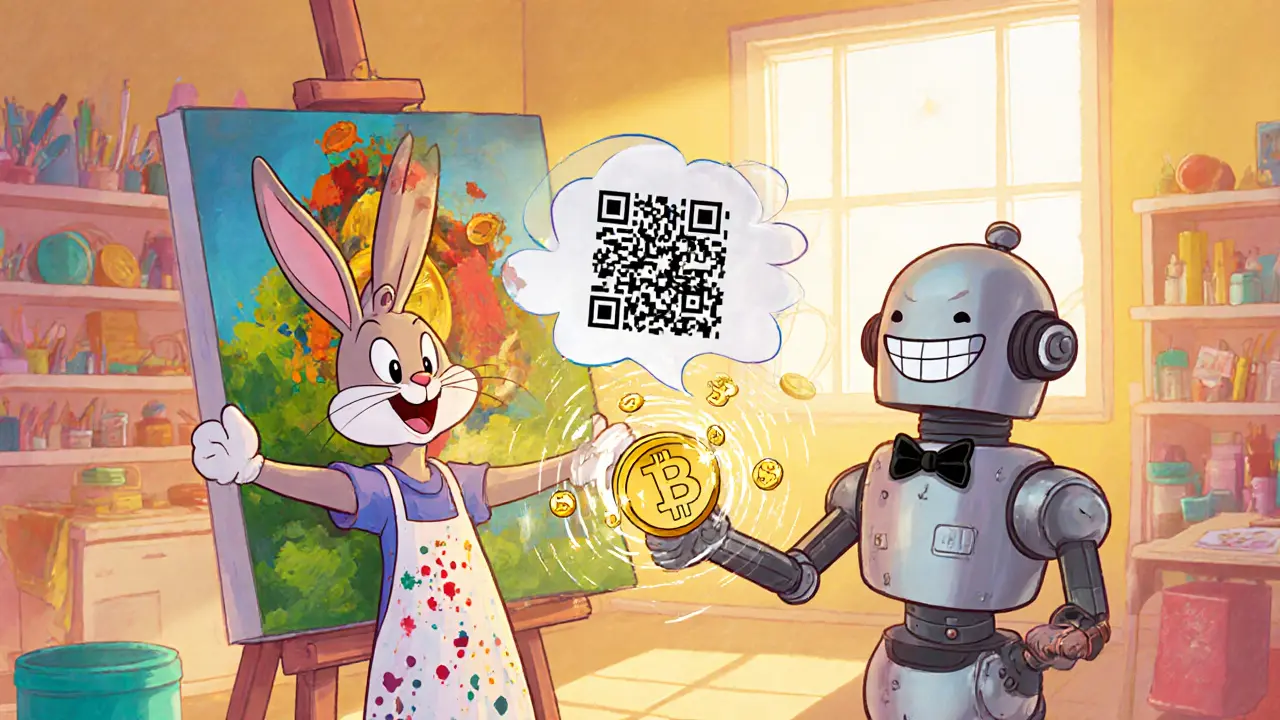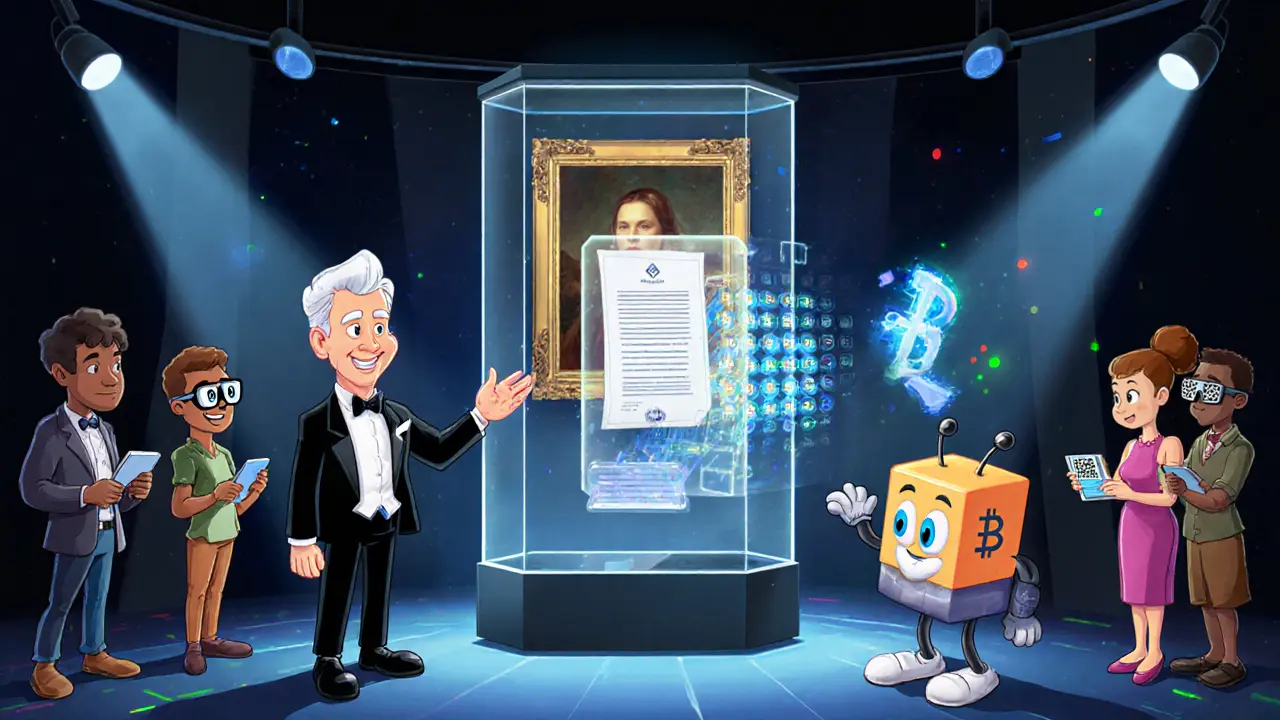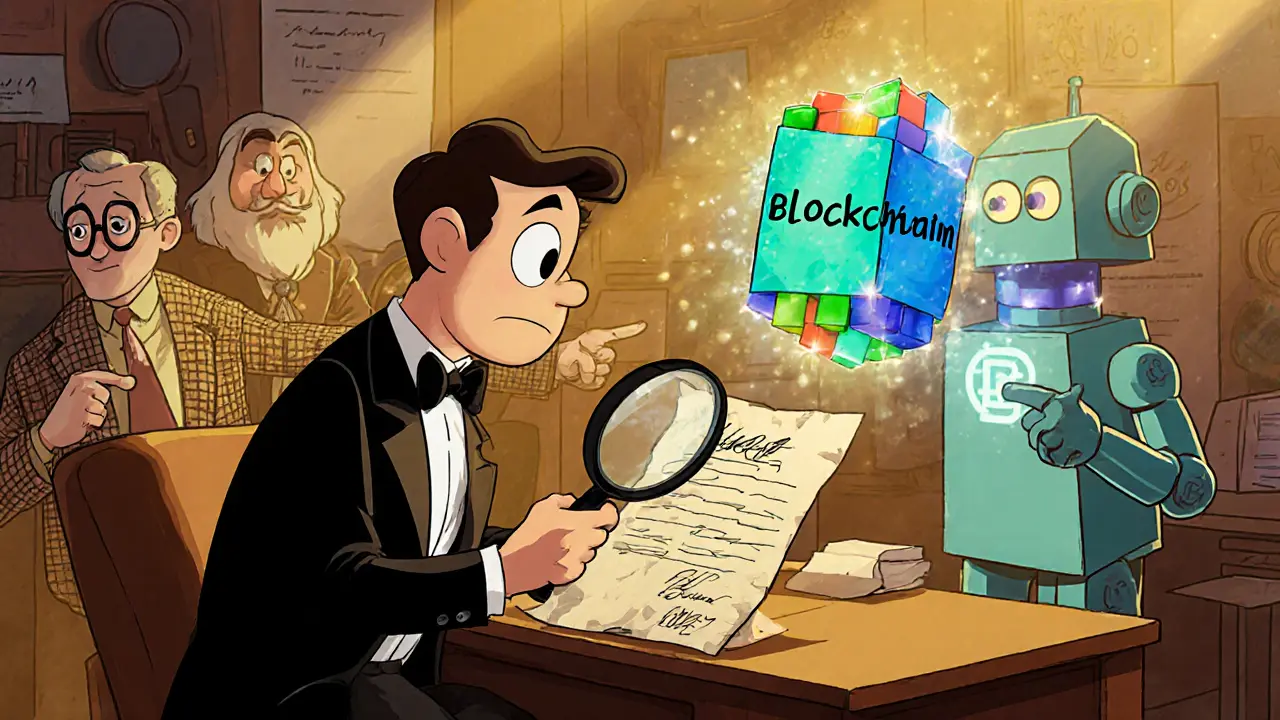Blockchain Provenance vs Traditional Authentication Comparison
Blockchain Provenance
- Immutability: Data cannot be altered without network consensus
- Transparency: Public ledger viewable by anyone (anonymous)
- Verification Speed: Instant online check (seconds)
- Cost of Verification: Low transaction fee, minimal expert time
- Risk of Loss: Distributed storage prevents single-point failure
- Royalty Automation: Smart contracts enforce resale royalties
- Accessibility: Anyone with a wallet can view provenance
Traditional Authentication
- Immutability: Paper certificates can be forged or altered
- Transparency: Records often siloed in private archives
- Verification Speed: Requires expert review (days-weeks)
- Cost of Verification: High expert fees, insurance costs
- Risk of Loss: Physical documents can be misplaced or destroyed
- Royalty Automation: Manual royalty agreements, often ignored
- Accessibility: Access limited to institutions or brokers
Key Benefits Summary
Immutable records make forgery nearly impossible
Automated checks replace expensive expert reviews
Smart contracts ensure artist royalties
Potential Drawbacks
Requires understanding digital wallets and cryptography
Minting NFTs incurs transaction fees
Implementation Steps
- Choose a reputable platform: Verisart, Artory, or gallery-partnered service
- Verify your identity: Provide government ID and artist registry numbers
- Gather metadata: High-resolution photos, material list, creation date
- Mint the NFT: Upload metadata and pay transaction fee
- Attach physical link: Place QR code or NFC tag on artwork
- Record first sale: Transfer token to buyer's wallet
- Maintain the chain: Ensure proper resale handling with smart contracts
When a collector asks, “Is this piece really by the artist?” the answer often hinges on how well the artwork’s history is documented. For centuries, that history has lived in paper files, expert opinions, and fragmented databases. Blockchain provenance is a digital ledger that records every creation detail and ownership change in a way that can’t be altered without leaving a trace. In this article we’ll break down how that technology stacks up against the old‑school approach, show real‑world platforms that already use it, and give you a step‑by‑step guide if you’re thinking about making the switch.
Key Takeaways
- Traditional authentication relies on physical certificates and expert analysis, which can be lost, forged, or incomplete.
- Blockchain provenance creates an immutable, time‑stamped record that anyone can verify, reducing fraud risk.
- Smart contracts and NFTs add automatic royalty payments and transparent ownership transfers.
- Adoption costs are dropping, but artists and galleries must learn wallet management and basic cryptography.
- Hybrid models-using both expert opinion and blockchain data-are emerging as the most practical solution today.
How Traditional Art Authentication Works
Traditional authentication is a multi‑layer process that usually begins with a physical certificate of authenticity (CoA). The CoA includes the artist’s signature, a description of the work, the creation date, and often a provenance chain written on paper or stored in a private database. Experts-often affiliated with museums, auction houses, or independent scholars-examine materials, brushwork, and historical context. When they agree, they issue a written statement that becomes part of the artwork’s documented history.
These records are stored in places like the Getty Provenance Index or the Art Loss Register. While these institutions are reputable, the data is still centralized, vulnerable to loss, and difficult for a buyer to access quickly. If a certificate is forged or a previous owner disappears, the chain can break, leaving the piece’s legitimacy in doubt.
How Blockchain Provenance Works
Blockchain provenance turns the CoA into a digital token stored on a distributed ledger. The artist creates a unique digital identity for the work-often an NFT (Non‑Fungible Token)-that contains:
- Artist name and verified ID
- Creation date, location, and materials used
- High‑resolution images and an artist statement
- Digital signature that cryptographically links the data to the token
- Smart‑contract terms for future sales, royalties, or profit‑sharing
When the artwork changes hands, the transaction is recorded as a new block on the chain. Because each block references the previous one, the entire ownership history forms an unbreakable chain of custody. Anyone can query the public ledger-without revealing personal data-to confirm that a token is genuine and see its full provenance.
NFTs serve as the digital certificates. Minting an NFT involves uploading the artwork’s metadata to a blockchain platform (e.g., Ethereum, Polygon) and paying a small transaction fee. Once minted, the token lives forever unless the owner deliberately burns it, and any attempt to edit the stored data would require consensus from the network-a practically impossible feat.
Smart contracts embedded in the NFT automate functions like 10% resale royalties back to the artist every time the piece is sold. This feature addresses a long‑standing grievance: artists rarely benefit from price appreciation after the first sale.

Side‑by‑Side Comparison
| Feature | Blockchain Provenance | Traditional Authentication |
|---|---|---|
| Immutability | Data cannot be altered without network consensus | Paper certificates can be forged or altered |
| Transparency | Public ledger viewable by anyone (anonymous) | Records often siloed in private archives |
| Verification Speed | Instant online check (seconds) | Requires expert review (days‑weeks) |
| Cost of Verification | Low transaction fee, minimal expert time | High expert fees, insurance costs |
| Risk of Loss | Distributed storage prevents single‑point failure | Physical documents can be misplaced or destroyed |
| Royalty Automation | Smart contracts enforce resale royalties | Manual royalty agreements, often ignored |
| Accessibility for Buyers | Anyone with a wallet can view provenance | Access limited to institutions or brokers |
Real‑World Platforms Using Blockchain
Several services have taken the theory and turned it into daily practice:
- Verisart issues blockchain certificates for both physical and digital artworks, letting collectors scan a QR code to see the full chain.
- Maecenas enables fractional ownership of high‑value pieces, using smart contracts to split royalties among multiple investors.
- Masterworks combines traditional appraisal with blockchain recording to let investors buy shares in blue‑chip art.
These platforms illustrate how blockchain can open the market to smaller investors, reduce paperwork, and provide insurers with a trustworthy provenance trail.
Benefits and Drawbacks
Benefits
- Fraud reduction: Immutable records make it nearly impossible to sell a forged piece with a fake history.
- Lower verification costs: Automated checks replace expensive expert opinions for basic authenticity.
- Enhanced liquidity: Fractional ownership and transparent history attract more buyers and lenders.
- Royalty enforcement: Smart contracts ensure artists receive a share of secondary market sales.
- Global reach: A buyer in Singapore can verify provenance instantly without contacting a NewYork auction house.
Drawbacks
- Technical learning curve: Artists and galleries must manage digital wallets and understand basic cryptography.
- Initial costs: Minting NFTs incurs gas fees, though these are dropping with newer layer‑2 solutions.
- Regulatory uncertainty: Some jurisdictions still lack clear rules for tokenized art.
- Environment concerns: Early blockchains were energy‑intensive; many now use proof‑of‑stake to mitigate impact.
- Adoption lag: Not all buyers trust blockchain yet, so hybrid documentation may be required.

How to Implement Blockchain Provenance for Your Artwork
- Choose a reputable platform: Verisart, Artory, or a gallery‑partnered service.
- Verify your identity: Provide government ID and artist‑registry numbers; the platform creates a verified digital profile.
- Gather metadata: High‑resolution photos, material list, creation date, location, and a written statement.
- Mint the NFT: Upload the metadata, pay the transaction fee, and receive a unique token ID.
- Attach a physical link: Place a QR code or NFC tag on the artwork that points to the token’s ledger entry.
- Record the first sale: Transfer the token to the buyer’s wallet; the blockchain automatically logs the transaction.
- Maintain the chain: For every resale, ensure the new owner receives the token and the smart contract executes any royalty clauses.
Many platforms offer step‑by‑step video guides and community forums, making the process accessible even for non‑techy creators.
Future Outlook
According to the Deloitte‑ArtTactic Art & Finance Report 2023, transparency and risk management are the top drivers of confidence in the art market. As blockchain platforms mature, we expect three trends to dominate:
- Standardized token schemas: Industry bodies are drafting common data fields so every token can be read by any marketplace.
- Integration with insurance and lending: Lenders will pull the immutable provenance record directly from the blockchain to assess collateral value.
- Hybrid verification models: Experts will still provide connoisseurship, but their reports will be anchored to blockchain records for added credibility.
In short, blockchain provenance isn’t a magic bullet, but it offers concrete tools to close the gaps that have plagued the art world for centuries.
Frequently Asked Questions
Can I still use a traditional certificate alongside a blockchain token?
Yes. Many collectors keep the paper CoA for legal purposes while also linking it to an NFT. This hybrid approach satisfies institutions that still require physical documentation.
What blockchain is best for art authentication?
Ethereum is the most widely adopted, but layer‑2 solutions like Polygon or Flow offer lower fees and faster confirmation times. Choose a network that the platform you trust supports.
Do buyers need a crypto wallet to view provenance?
No. Most platforms provide a public viewer that lets anyone scan a QR code and see the ledger entry without logging in.
How are royalties enforced if the artwork is sold offline?
The smart contract only triggers on blockchain transactions. For offline sales, parties must manually record the transfer on the ledger, or use a mixed‑mode escrow service that logs the move as a blockchain transaction.
Is blockchain provenance legal evidence in court?
Courts in several jurisdictions (e.g., the UK, Singapore) have accepted blockchain records as admissible evidence, provided the chain’s integrity can be demonstrated. Still, pairing it with traditional documentation strengthens the case.

Great overview! I love how you broke down the benefits of blockchain provenance in a way that's easy to follow. It really shows how tech can help protect artists.
The comparison feels like a modern philosophy class on trust. When we talk about immutable ledgers, we’re speaking to a deeper human desire for certainty. Traditional certificates feel fragile, like a sandcastle at high tide. Blockchain offers a kind of permanence that aligns with our longing for lasting legacy.
Wow!!! This article nails it, and the speed advantage alone makes traditional methods look like dial‑up internet!!
Imagine waiting weeks for a signature when you could verify in seconds!!!
It’s a game‑changer for collectors, galleries, and even casual buyers!!
Reading this felt like watching a sci‑fi thriller unfold-blockchains as the new guardians of art! The drama of a token soaring across the globe, each transaction a pulse of authenticity, is pure cinematic gold. I can almost hear the roar of the crowd as a piece is verified instantly. It’s a bold new era, and we’re all front‑row witnesses.
Sure, but what about the hype?
Yo, this is lit. Blockchain makes the whole thing easy peasy, no more endless paperwork lol.
We must not overlook the ethical implications of turning art into code. While technology can reduce fraud, it also risks commodifying cultural heritage. Artists deserve protection beyond mere profit, and any system must honor their creative spirit. Let’s demand transparency that respects both art and artist.
While the enthusiasm is commendable, one must scrutinize the underlying assumptions. The purported immutability of blockchains hinges on network consensus, which is not infallible. Moreover, the energy consumption of certain chains raises sustainability concerns. A rigorous cost‑benefit analysis is indispensable before wholesale adoption.
Don’t be fooled by the shiny interface! Every blockchain transaction is a data point that can be tracked, correlated, and eventually used to profile buyers. The so‑called “privacy” is an illusion, and the fees are just a front for a deeper surveillance apparatus. Think twice before handing over your wallet address.
It’s exciting to see technology bridging gaps, but let’s keep the conversation inclusive. Artists, collectors, and historians all benefit when provenance is transparent and accessible. A balanced approach that respects both tradition and innovation will foster a healthier market.
Honestly, the article glosses over how many scams still slip through. Just because a token exists doesn’t guarantee the physical piece matches it. There’s work to be done on verification standards before we call this a cure‑all.
Oh sure, because converting art to a digital token magically solves every problem. Next thing you know we’ll be auctioning coffee beans as NFTs. Let’s keep the sarcasm in check and remember real expertise still matters.
I get why people love the tech, but there’s also a human side that can’t be coded. Seeing a brushstroke in person is a connection you can’t replicate on a ledger.
Look, the whole blockchain buzz is part of a larger agenda to digitize every facet of our lives, and art is just the newest frontier. The “decentralized” narrative masks the fact that a handful of platforms control the standards, the gas fees, and the very infrastructure that artists rely on. Every transaction leaves a trail that can be aggregated, creating a data vault that governments could tap into under the guise of regulation. Meanwhile, the environmental impact of proof‑of‑work chains remains a massive, often ignored, externality. If we truly want to protect cultural heritage, we need open‑source, low‑energy solutions and a governance model that includes artists, not just technocrats.
Great points! I think the balance between new tech and the tried‑and‑true methods is where real progress lives. The article does a solid job of laying out pros and cons, and it’s a helpful starting point for anyone new to the space.
Love this! 🚀
From a formal perspective, the integration of smart contracts into provenance records represents a significant advancement in contractual enforcement. The precision of code eliminates ambiguity that has plagued manual royalty agreements for decades. Moreover, the immutable nature of blockchain entries provides an audit trail that is both verifiable and tamper‑resistant. While adoption challenges remain, especially among less‑tech‑savvy stakeholders, the long‑term benefits to market transparency are undeniable.
When we step back and look at the whole picture, it becomes clear that blockchain provenance is more than just a technical novelty; it’s a paradigm shift in how we think about trust and value in the art world.
First, the immutable ledger addresses a centuries‑old problem of forgery, giving artists and collectors a reliable way to prove authenticity.
Second, the transparency of a public ledger democratizes access to provenance data, reducing the gatekeeping power of a few elite institutions.
Third, smart contracts automate royalty payments, ensuring that creators continue to benefit from the appreciation of their work over time.
Fourth, the distributed nature of the technology mitigates the risk of single‑point failures that have historically plagued physical archives.
Fifth, the low‑cost verification process can lower barriers for emerging artists who previously could not afford expert appraisals.
Sixth, integrating QR codes or NFC tags on physical pieces creates a seamless bridge between the tangible and digital realms.
Seventh, the global reach of blockchain means a buyer in Tokyo can instantly verify a work’s history without contacting a New York auction house.
Eighth, the environmental concerns associated with early proof‑of‑work chains are being tackled by newer proof‑of‑stake solutions, making the technology more sustainable.
Ninth, hybrid models that combine expert connoisseurship with blockchain data offer the best of both worlds, preserving human insight while leveraging technological rigor.
Tenth, regulatory frameworks are beginning to recognize tokenized assets, providing a legal backbone for future growth.
Eleventh, the data standards being drafted by industry bodies will soon allow different marketplaces to read each other’s tokens effortlessly.
Twelfth, insurance companies are already exploring blockchain‑based provenance as a factor in underwriting art‑related risk.
Thirteenth, the increased liquidity from fractional ownership platforms opens new investment opportunities for a broader audience.
Fourteenth, the traceability of transactions can help combat illicit trade and aid law‑enforcement efforts.
Fifteenth, the cultural impact of preserving artists’ rights in a transparent system fosters a healthier, more equitable creative ecosystem.
All of these points together illustrate why embracing blockchain provenance isn’t just a trend-it’s a strategic move toward a more resilient and inclusive art market.
I appreciate the thorough breakdown, especially the step‑by‑step guide for artists. It removes a lot of the intimidation factor. The mention of layer‑2 solutions for lower fees is spot‑on, as costs have been a major hurdle. Hopefully more platforms will adopt these approaches and make the process truly accessible.